In this article:
Planting and tending to your veggie, fruit, and flower gardens provide healthy food for you and your family as well as beautify your yard. It can even help improve the environment when certain gardening practices are used.
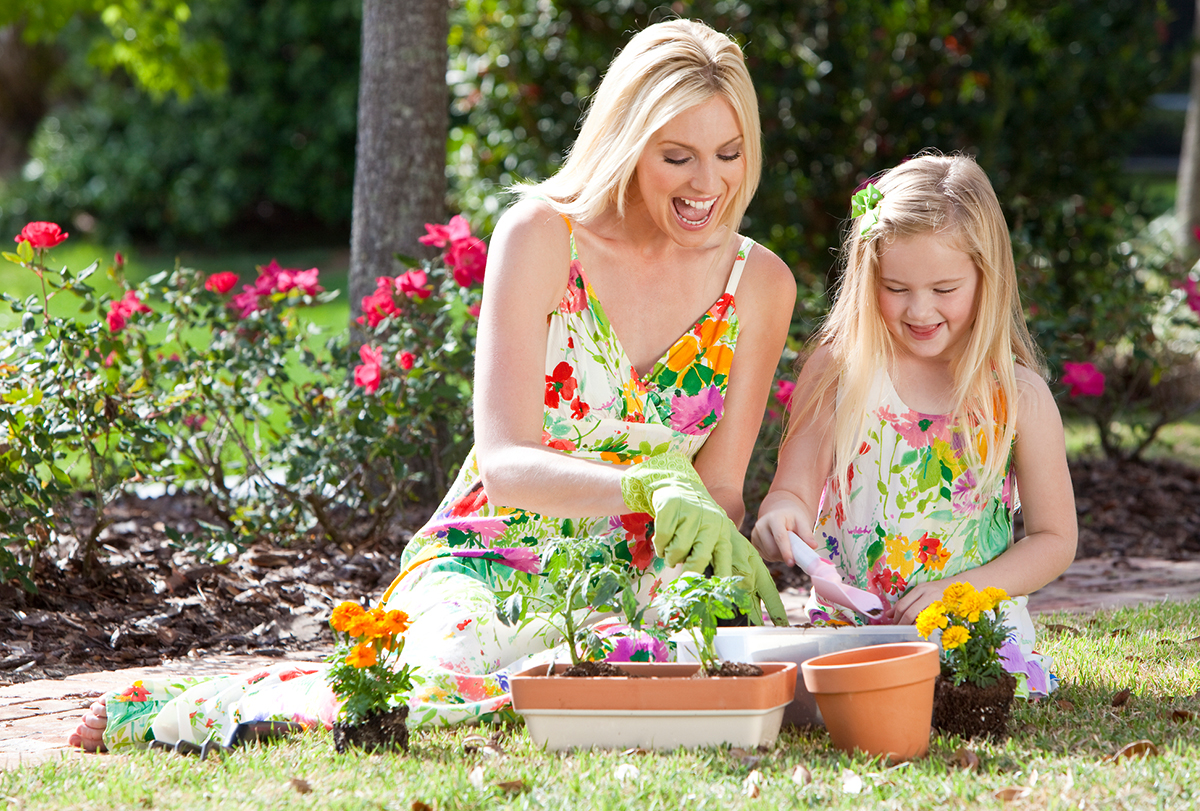
Gardening has other positive impacts as well. Did you know that this seemingly routine activity can actually extend your life? Besides being a fun and effective form of exercise, gardening is also recognized for its therapeutic values that provide a natural outlet for stress relief.
Several studies show that gardening is linked to a longer life. A study published in Activities, Adaptation & Aging asserts that gardening has numerous therapeutic benefits for the elderly. (1)
Not only this, the emerging concept of “horticulture therapy” is proving extremely beneficial for improving your overall health. This therapy focuses on engaging with nature for mental and physical rehabilitation. It mediates emotional, cognitive, and/or sensory-motor functional improvement, increased social participation, health and well-being, and life satisfaction.
A study published in the Journal of Nursing Research substantiates the effectiveness of horticulture therapy on your health. (2)
How to Get Started
It’s never too late to hop onto the gardening bandwagon. Setting up your first garden doesn’t require you to have the greenest thumb in all of the land or a sizeable backyard space to spare. All it takes is a little resourcefulness and preliminary knowledge of the most basic gardening guidelines to get you started.
During this amateur phase, it’s best not to get ahead of yourself and plant too much too soon. Instead, pick out a few corners of the home where you may like a house plant or two. Observe the conditions in those locations. How much sunlight do you get there? How many hours of sunlight do you get there? What is the quality of sunlight – intense or dim? Is it really humid in your region?
Take the collected information and do a little research and find some house plant options for those spaces, and then take a stab at growing just a few houseplants as the first step toward gardening.
To make the garden even less daunting, you can plan it out in advance. Sketch a little landscape map or make a simple crop schedule, which tells you what to plant depending on whether you are using small plants or seeds. You can start out small by sowing your plants in containers and then gradually expanding your gardening space to a few feet of cultivable stretch.
Looking after a sprawling garden space can prove to be a big task for gardening newbies, especially because it requires a lot of energy, time, commitment, and effort on your part. The right horticultural spirit is to revel in the success of a small garden rather than be disappointed by a big one!
If you don’t have access to your own gardening space, you can sign up for a plot at a community garden. Being part of a community garden often has benefits such as shared resources, a network of skilled gardeners, and social opportunities. You can even take advantage of your patio or windowsill.
Just a few fresh herbs will improve the taste of your cooking and reduce the waste that comes with all of those clamshells of fresh herbs you can never use up in time. A small herb garden isn’t overwhelming and doesn’t take space but still offers many therapeutic and health benefits.
Health Benefits of Gardening
Here are some of the numerous benefits that gardening provides.
1. Reduces stress
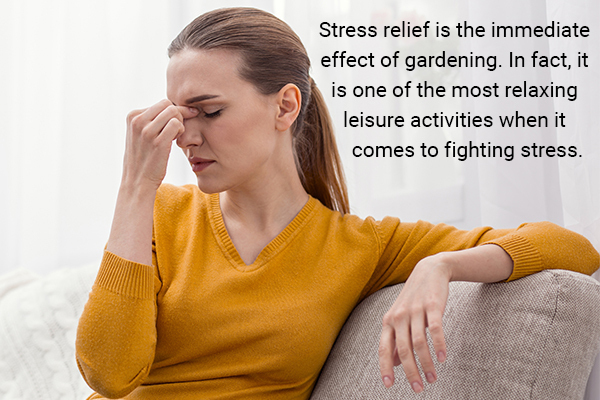
Stress relief is the immediate effect of gardening. In fact, it is one of the most relaxing leisure activity when it comes to fighting stress.
The very sight and smell of flowers and plants promote relaxation and peace of mind. The sound of leaves, rain, and soft wind and the aura in itself has a therapeutic effect, which brings you closer to a stress-free mind and later a blissful sleep. Specific smells can trigger nostalgia or memories.
Exposure to sunlight while gardening increases the secretion of serotonin (a natural antidepressant) and melatonin (the sleep hormone) in the brain, thus keeping the brain balanced and stress-free and inducing a healthy sleep cycle by maintaining the circadian rhythm (the brain’s internal biological clock). It also assists in obtaining vitamin D, which is known to fight depression.
In addition, gardening keeps your mind distracted from your problems for a while. It calls for deliberate mental focus on gardening actions, which helps you forget or set aside your personal problems while engaging in the tasks.
A 2016 report in the Journal of Public Health indicates that one single session of allotment gardening can improve both self-esteem and mood, irrespective of how long participants spend on the allotment. Furthermore, allotment gardeners have a better level of self-esteem and mood and a reduced level of abnormal psychological functioning than nongardeners. (3)
A study published in the Journal of Health Psychology asserts that gardening promotes neuroendocrine and affective restoration from stress. It states that gardening leads to reduced levels of cortisol (the stress hormone) in the brain and infuses positive moods that promote relief from stress. (4)
2. Fights depression
The effortless attention of gardening helps improve symptoms of depression. Gardening activity helps reduce the secretion of cortisol and aids recovery from depression.
Another study published in Research and Theory of Nursing Practice suggests that therapeutic horticulture can be used for treating clinical depression. It may decrease depression severity and improve perceived attention capacity by engaging effortless attention and interrupting rumination. (5)
According to a 2015 study published in the Journal of Rehabilitation Sciences and Research, the purposeful activity of gardening had positive effects on decreasing depression in depressed female students. (6)
Scientists have even come up with horticulture therapy, a gardening routine for individuals with serious mental health issues and disorders, which helps in recovery and rehabilitation. Horticulture therapy is also used in persons with disabilities.
3. Improves cognitive health
A few studies suggest that physical activity associated with gardening is helpful in lowering the risk of developing dementia.
In a 2017 study published in Occupational Therapy in Mental Health, 20 adults with severe mental illness demonstrated significant improvement in mood and markedly higher levels of involvement and spontaneity when engaged in gardening. Positive changes in diet and social interaction were also reported. (7)
A 2016 study published in the Journal of Alzheimer’s Disease reported that a variety of physical activities, from walking to gardening to dancing, can improve brain volume and cut the risk of Alzheimer’s disease by 50 percent. (8)
4. Adds physical activity to your routine
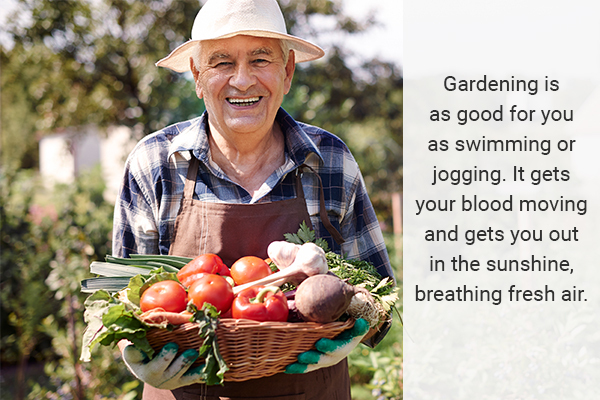
Gardening is as good for you as swimming or jogging. It gets your blood moving and gets you out in the sunshine, breathing fresh air.
Different actions of gardening, such as gripping, stooping, lifting, stretching, walking, standing, kneeling, sitting, and squatting, require body movements that provide exercise benefits.
In fact, activities like digging and raking are considered to be high-intensity physical activities, whereas other activities are considered moderate-intensity physical activities. (9)
A 2014 study published in HortTechnology asserts that gardening activities performed by adults are moderate- to high-intensity physical activities. (10)
Gardening activity is an excellent form of exercise requiring repetitive strength and stretching, enabling your body to move. The best part is it is pleasurable and hence you stick to it and do it more often.
According to the Centers for Disease Control and Prevention (CDC), 2.5 hours of a moderate-intensity exercise activity each week is very helpful in reducing the risk of high blood pressure, obesity, depression, type 2 diabetes, osteoporosis, heart disease, strokes, colon cancer, and premature death. The CDC considers gardening to be a moderate-intensity level activity that can help you achieve your 2.5-hour goal. (11)
5. Provides organic produce
One of the most beneficial aspects of gardening is the ability to produce your own high-quality, pesticide-free fruits and vegetables.
The food that you grow yourself is the freshest and healthiest that you can eat. No toxins, no pesticides, no preservatives, just raw, organic, healthy, and fresh! Plus, you can choose your own organic fertilizers.
Gardening also gives you an opportunity to harvest foods at their peak time, thus retaining all their nutrients, which are otherwise lost in fruits due to early picking (unripe) for safe shipping.
A 2011 study published in NJAS – Wageningen Journal of Life Sciences analyzed several studies and indicates the potential health effects of organic food. However, future studies are needed in several areas. (12)
It has also been found that those who grow their own food tend to eat healthier, including more fruits and vegetables, than others. In fact, gardeners tend to eat one or two more servings of fruits and raw vegetables than those who are not into gardening.
Not to mention that homegrown produce simply tastes better and gives you more satisfaction.
6. Burns calories
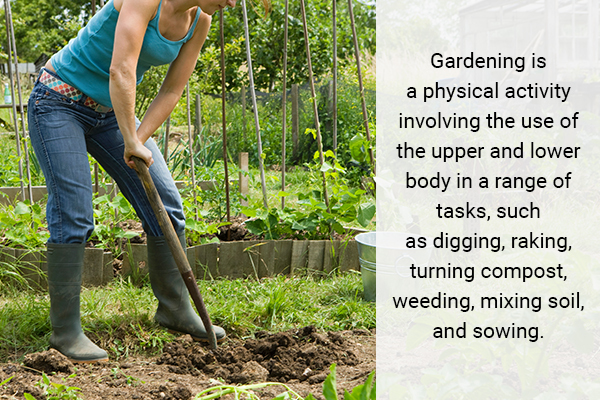
Gardening is a physical activity involving the use of the upper and lower body in a range of tasks, such as digging, raking, turning compost, weeding, mixing soil, and sowing. These activities range from moderate-intensity physical exercises to slow but with frequent standing or squatting postures.
In fact, although unintentionally but surprisingly, you tend to perform 45 to 50 squats in a one- or two-hour gardening session. And this is just enough to keep your waistline trimmed!
A 2018 study published in Current Research in Nutrition and Food Science found that community vegetable gardening increased vegetable intake among the subjects and made them physically active, which led to improved body weight, BMI, and waist circumference. (13)
Further, calorie counters from the CDC estimate that you can burn up to 330 calories in just one hour of light gardening and yard work. And that is more than most other moderate-intensity activities for the same amount of time! (14)
So, if you wish to keep in shape or are looking forward to dropping a few inches, you can engage in 30 to 45 minutes of gardening three to five times a week.
7. Improves heart health
Gardening is an excellent form of exercise that helps keep heart attacks, strokes, and several other serious diseases at bay. It requires exposure to sunlight, which fulfills your body’s requirement of vitamin D, thus reducing the risk of several diseases.
Experts recommend getting at least 2.5 hours of moderate-intensity physical activity for improving your heart health, and gardening is a fun way to achieve that goal.
A study published in HERD found that exposure to organized gardens can affect both the mood and cardiac physiology of elderly individuals. Our data further suggest that these effects can differ depending on the types of landscape to which an individual is exposed. (15)
Not only this, but gardening has acquired a place on the National Heart, Lung, and Blood Institute list for fighting blood pressure issues. (16)
8. Fights osteoporosis and improves muscle strength
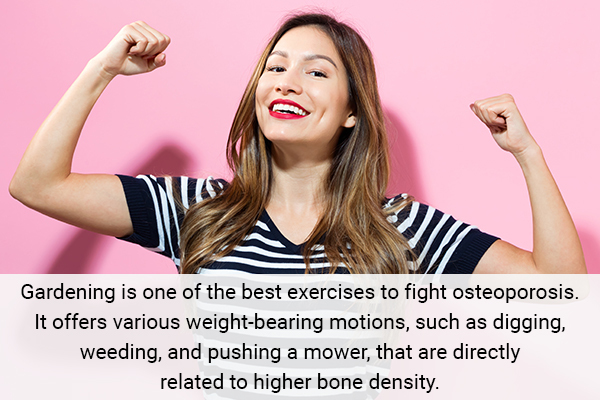
Gardening is one of the best exercises to fight osteoporosis.
It offers various weight-bearing motions, such as digging, weeding, and pushing a mower, that are directly related to higher bone density. Digging, planting, and weeding in the garden require strength and engage most of your muscle groups, which causes their repetitive stretching and contraction, forming a good workout. (17)
Osteoporosis is a condition characterized by weak and brittle bones. This usually happens due to lack of physical activity in adults older than 50 years of age. Gardening is, thus, one effective way to fight this.
Plus, as gardening encourages you to stay out in the sun, it helps you soak sunlight that helps your body make vitamin D. This sunshine vitamin helps in increasing absorption of calcium in the body, thus contributing to improved bone and muscle density and improved muscle strength.
In an article published in Osteoporosis & Women’s Health, it is recommended to try gardening to cut your risk of developing osteoporosis or “fragile bone disease.”
Even the University of Vermont Extension Department of Plant and Soil Science says that, of all types of exercise, only gardening and weight training that involve weight-bearing motions help build strong bones and muscles. (18)
Also, pulling weeds, pushing a wheelbarrow or lawnmower, and turning over soil improve balance, which is important to reduce the risk of falls and possible bone fractures and breaks. Gardening works wonders in improving the health and strength of your muscles by keeping them active, vigorous, and agile.
Undertaking garden tasks is excellent for the strength and flexibility of your hands. Additionally, it is extremely beneficial for those above the age of 60 who are experiencing diminished dexterity and weak and unstable hands and legs.
By working your hands and keeping them active, gardening maintains and improves the strength and dexterity of the muscles. Gardening activities like trimming plants, pulling weeds, and moving the dirt with your hands help in proper blood circulation and muscle flexibility, thus improving hand strength.
9. Better immunity
Gardening is also great for boosting your immune system. Sun exposure during gardening aids your body in producing vitamin D, which gives a boost to your immunity and helps you fight off colds and the flu.
A study published in the Journal of Investigative Medicine reported that vitamin D has important functions beyond those of calcium and bone homeostasis, which include modulation of the innate and adaptive immune responses. (19)
Did you ever think that the exposure to dirt while gardening could be favorable for your health? Well, yes! There are strains of friendly soil microbes like Mycobacterium vaccae that help alleviate symptoms of asthma, psoriasis, and allergies.
They also cause an increase in cytokine levels in the brain, which in turn leads to increased production of serotonin (a feel-good brain chemical). So, enjoy your gardening activity and get your hands dirty.
Kids Love to Grow Plants
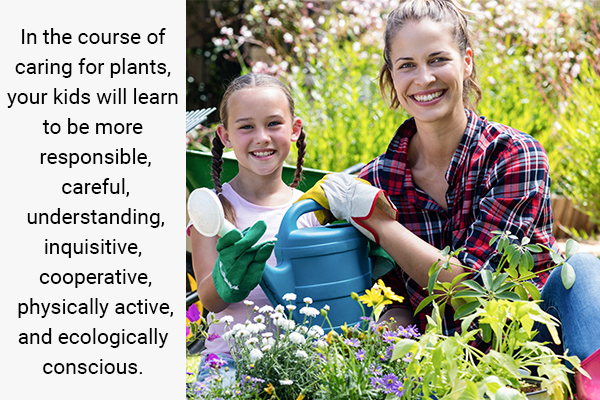
Gardening can be a fun hands-on experience for your young ones as well. Because children are inherently curious beings, they are likely to take a special interest in the workings of nature and what goes into growing a plant. It also introduces kids to the bounty of smells and textures offered by nature. Sensory activities are linked to certain therapies.
Introducing kids to the realm of gardening can be a fun way to increase their awareness of where food comes from and the importance of the environment in everyday life.
It is also a fun way to integrate biology as well as many other science specialties such as botany, systematics, and horticulture into an “outdoor classroom” for a change of pace in education. The young mind can get a firsthand understanding of the lifecycle process by observing a seed grow into a full-blown plant over time.
Kids also benefit from the physical activity of gardening. In a world so reliant on electronics, finding enjoyable ways to get physical activity can be a difficult venture, but getting out there in the garden is enjoyable for many.
Your kids will follow your lead as you work your way around a garden. Thus, this activity can be used as an opportunity for quality time with your family and community. It can also be used as an opportunity to inculcate important life skills in them through simple tasks.
In the course of caring for plants, your kids will learn to be more responsible, careful, understanding, inquisitive, cooperative, physically active, and ecologically conscious. In fact, gardening holds a lesson for anyone who is willing to get their hands dirty.
Protect Yourself When You’re Gardening
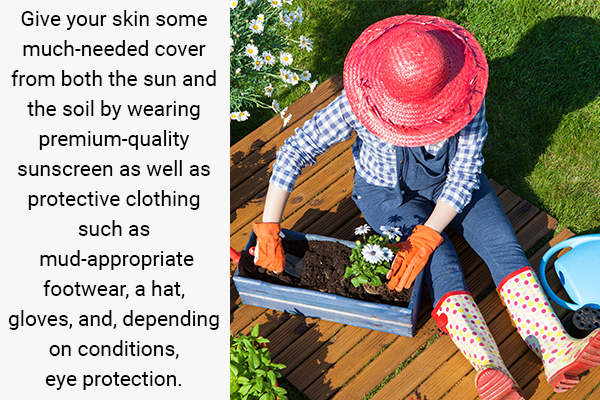
The perks of gardening should not be pursued at the expense of your health and safety. Keeping in mind basic body mechanics and other key considerations, adhering to the following tips will go a long way in preventing injuries while gardening outdoors:
- Give your skin some much-needed cover from both the sun and the soil by wearing premium-quality sunscreen as well as protective clothing such as mud-appropriate footwear, a hat, gloves, and, depending on conditions, eye protection.
- Because gardening requires your body to maneuver a lot, prime your joints and muscles for action through a good warmup before getting down to business. Flexing, bending, and stretching will help loosen your body for the heavy lifting that lies ahead.
- Try not to overburden your body by putting it through laborious tasks for a prolonged period on end. Take a breather from time to time, and don’t forget to stretch and change position often to avoid stiffness in your back, neck, or knees.
- When lifting a heavy object, avoid doing so with locked needs or by bending straight from the waist. Instead, squat down to pick up the load, and then slowly lift using the muscles in your hips and knees. This strategy helps disperse the pressure of the load over the entire body, rather than straining any particular joint, muscle, or tendon.
- Working in the sun, particularly during the warm seasons, can render you quite dehydrated. Make sure to replenish your fluid intake.
- Keep your garden tools and equipment safely stashed in a dry place, such that they remain out of everyone’s way. This is particularly true if there are children in the house, as they can meddle with sharp gardening tools or play with chemical fertilizers leading to injuries.
- Anyone with the slightest gardening knowledge would be aware of the potentially hazardous effects of potting mix as well as sprays or fertilizers. Thus, it is essential that you observe the safety instructions that come along with these common gardening fixtures.
- Rolling your shoulders backward, moving your head from side to side, and a gentle backward bending of your lower back with your hands on your hips are some easy ways to minimize stiffness.
- Keeping your spine properly aligned while working enables the body to absorb shock better and allows for proper weight distribution and optimal range of motion.
- Minimize your area of operation by keeping your work tools and other necessary objects within close reach. Heavy objects such as filled garden sacks and lawn mowers should especially be kept close to the body and your arms should be bent.
- The ideal position for tending a garden is at waist height with elbows bent and arms comfortably at your sides.
- Don’t try to pack in too much work in one day and spread it out over a couple of days.
- When you are required to reach down to ground level for planting or weeding, avoid stooping with your legs straight. Instead, bend your knees, squat, or kneel to get the job done. Alternatively, you can invest in a small stool or buy a foam mat to rest your knees on. Knee pads can also be useful. All these methods will help take the pressure off your back.
Final Word
Getting down and dirty in the soil, designing your landscape, and pruning and tending to plants are all activities that can reestablish your lost connection with nature, offering you some much-needed “me time” away from the frantic hustle and bustle that mar the everyday lives of many.
As a form of exercise, gardening has several benefits for your social, physical, and psychological health that can add years to your life. The act of gardening requires an amount of focus that can take you into an altered state of consciousness, similar to the one during a meditation routine. This state is truly refreshing, tranquil, and spiritual.
Regular participation in this activity has many positive repercussions that translate into everyday life, including a more relaxed, clear, and/or positive outlook that can allow you to be the best version of yourself.
- Was this article helpful?
- YES, THANKS!NOT REALLY


